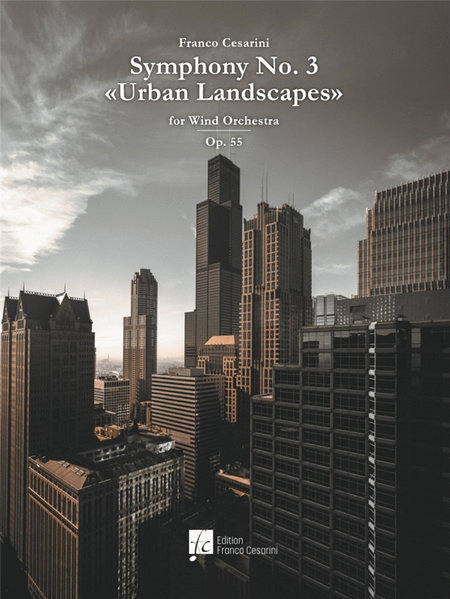Symphony Nr. 3 Urban Landscapes Op. 55
for Wind Orchestra, Full Score
-
Ships in 2 to 3 weeks
Details
Description
SKU: BT.EFC001-SC
For Wind Orchestra, Full Score. Composed by Franco Cesarini. Concert Piece. Score Only. Composed 2021. 106 pages. Hal Leonard Europe #EFC001-SC. Published by Hal Leonard Europe (BT.EFC001-SC).Fascinated by the beauty of Chicago, Franco Cesarini has translated his emotions into music: this is how Symphony No. 3 “Urban Landscapes” Op. 55, was born, a musical portrait of this metropolis overlooking Lake Michigan.
The composition is divided into three movements: The Wrigley Building from Dawn to Noon, Blue Silhouette and Cloud Gates, which by sharing the same thematic material arranged in cyclical form, strengthen the overall cohesion of the piece.
The first movement, preceded by a short slow introduction in which the main theme is presented in an almost dreamlike form, metaphorically represents the city at dawn. The sudden change of time symbolizes the start of activities with all its noises and sounds: you can hear the bell that announces the closing of the subway doors, the sound of cars speeding by, the siren of a patrol car.
If the first movement represents the day, the second introduces a nocturnal environment: a melancholic melody played by the English horn anticipates a more animated tempo depicting melodies coming from jazz clubs.
Powerful fanfares that take up the second theme of the first movement introduce the third movement. In this finale, the role of the two themes is reversed compared to the first movement and one takes the place of the other in a kind of games of mirrors.
Symphony No. 3 “Urban Landscapes” Op. 55: a sumptuous musical portrait of the “Windy City”.
Fasziniert von der Schönheit von Chicago hat Franco Cesarini seine Emotionen in Musik gefasst: so ist die Symphonie N. 3 „Urban Landscapes“ Op. 55, ein musikalisches Porträt dieser Metropole mit Blick auf den Michigansee, entstanden. Das Stück ist in drei Sätze unterteilt, The Wrigley Building von Sonnenaufgang bis Mittag, Blue Silhouette und Cloud Gates, die durch das Teilen des gleichen thematischen Materials in zyklischer Form einen starken Zusammenhalt bilden.
Dem ersten Satz geht eine kurze, langsame Einleitung voraus, in der das Hauptthema in einer verträumten Form die noch schlafende Stadt im Morgengrauen metaphorisch darstellt. Der plötzliche Tempowechsel symbolisiert den Beginn von Aktivitäten mit all seinen Geräuschen und Klängen: die Klingel, die das Schließen
der U-Bahn-Türe ankündigt, der Lärm der vorbeirasenden Autos, die Sirene eines Streifenwagens.
Während der erste Satz den Tag darstellt, führt der zweite in ein nächtliches Ambiente: eine melancholische Melodie des Englischhorns nimmt ein bewegtes Tempo vorweg, das später den Sound eines Jazzclubs darstellt.
Mächtige Fanfaren, die das zweite Thema des ersten Satzes aufgreifen, künden den dritten Satz an. Im Finale wird die Rolle der beiden Themen aus dem ersten Satz vertauscht und eines ersetzt das Andere in einer Art Spiegelspiel.
Symphonie N. 3 „Urban Landscapes” Op. 55: ein opulentes musikalisches Porträt der „Windy City“.
Fasciné par la beauté de Chicago, Franco Cesarini a traduit ses émotions en musique : c'est ainsi qu'est née la Symphonie N. 3 «Urban Landscapes» Op. 55, portrait musical de cette métropole surplombant le Lac Michigan. La composition est divisée en trois mouvements, The Wrigley Building de l’aube à midi, Blue Silhouette et Cloud Gate qui en partageant, sous une forme cyclique le même matériau thématique, confèrent à la pièce une forte cohésion.
Le premier mouvement, précédé d’une courte introduction, dans laquelle le thème principal est présenté sous une forme presque onirique, représente de façon métaphorique la ville à l’aube, encore endormie. Le brusque changement du tempo symbolise le début des activités avec tous ses bruits et sons : la cloche qui annonce la fermeture des portes du métro, les voitures qui passent à toute vitesse, la sirène d’une voiture de patrouille.
Si le premier mouvement représente le jour, le second introduit un environnement nocturne : une mélodie mélancolique du cor anglais anticipe des mélodies lointaines en provenance de clubs de jazz.
Des fanfares puissantes qui reprennent le deuxième thème introduisent le troisième mouvement. Dans ce final, le rôle des deux thèmes est inversé par rapport au premier mouvement et l’un prend la place de l’autre, dans une sorte de jeu de miroirs.
Symphonie N. 3 «Urban Landscapes» Op. 55 : un somptueux portrait musical de la «Windy City».
Affascinato dalla bellezza di Chicago, Franco Cesarini ha tradotto in musica le sue emozioni: così è nata la
La composizione si suddivide in tre movimenti: The Wrigley Building dall’alba a mezzogiorno, Blue Silhouette e Cloud Gate che condividendo in forma ciclica lo stesso materiale tematico, conferiscono alla composizione una forte coesione.
Il primo movimento, preceduto da una breve introduzione lenta, nella quale il tema principale è presentato in forma quasi onirica rappresenta metaforicamente la metropoli all’alba, ancora addormentata. Il cambio improvviso di tempo sta a simboleggiare l’inizio delle attività con tutti i suoi rumori e suoni: si sente la campana che preannuncia la chiusura delle porte della metropolitana, si sentono sfrecciare le automobili, la sirena di un’autopattuglia.
Se il primo movimento rappresenta il giorno, il secondo introduce un ambiente notturno: ad una malinconica melodia del corno inglese fa seguito un tempo più animato a descrivere lontane melodie provenienti dai jazz club.
Poderose fanfare che riprendono il secondo tema del primo movimento introducono il terzo movimento. In questo finale il ruolo dei due temi si ribalta rispetto al primo movimento e l’uno prende il posto dell’altro in una specie di gioco di specchi.
Sinfonia N. 3 “Urban Landscapes” Op. 55: un sontuoso ritratto musicale della “Windy City”.

 Share
Share